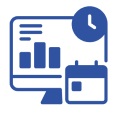
The SWPPP must identify potential sources of stormwater pollution and outline best management practices (BMPs) to mitigate those risks.

Routine Site Inspections: Sites must be regularly inspected by qualified personnel, especially after rainfall events (typically 0.25 inches or more).

Site conditions must be documented before and after construction to assess the effectiveness of BMPs and prevent long-term environmental damage.

The SWPPP must identify potential sources of stormwater pollution and outline best management practices (BMPs) to mitigate those risks.
DFR automatically logs daily precipitation amounts based on nearby rain gauge data. This removes the need for manual tracking and ensures accurate and timely updates, crucial for meeting inspection requirements after rainfall events.
Field personnel can take and upload site photos directly from the construction site, tagging them with relevant descriptions (such as “BMP installation” or “sediment control”). These images, paired with field notes, capture daily site conditions and BMP status, which is key for meeting visual inspection requirements.
DFR aggregates all the daily site information and allows for the rapid export of a PDF report complete with a summary of listed onsite personnel, activities, equipment, notes, and annotated media…all at the click of a button!
At the end of the year, export specific data needed to complete your regulatory compliance reports. Filter your exports by date ranges, tags, and many other attributes thereby staying organized and greatly simplifying the reporting process.
DFR helps streamline the stormwater documentation process!

Rain Event monitoring at multiple project sites using onsite construction personnel to photodocument site conditions.
Integration with Synoptic Data allows for selection of nearest weather station for precipitation tracking or contact us to add your own project-specific weather station.
DFR’s compilation and PDF export tool made it a sinch to submit daily visit reports to the owner and general contractor.
DFR made it really easy for me to capture field data, organize photos by date and tags, and stay on top of my reporting!
Rune Storesund - QSP/QSD
